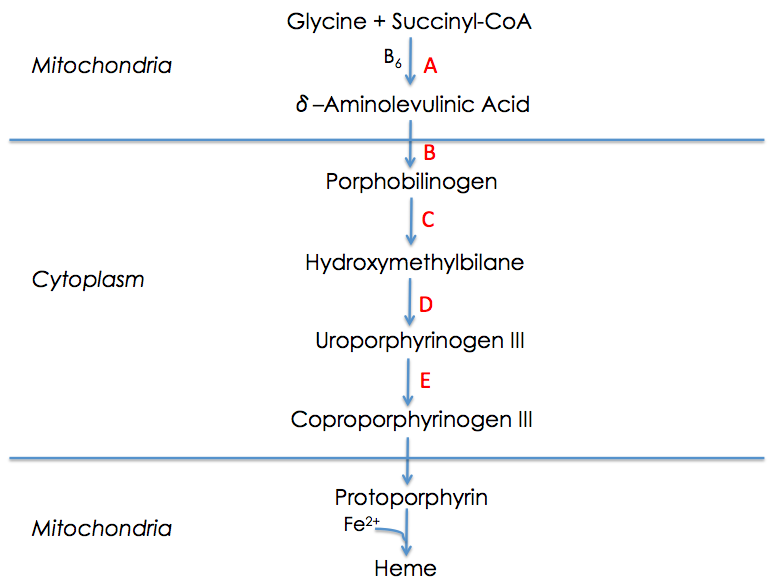WBR0347
| Author | [[PageAuthor::Rim Halaby, M.D. [1] (Reviewed by Alison Leibowitz)]] |
|---|---|
| Exam Type | ExamType::USMLE Step 1 |
| Main Category | MainCategory::Pathophysiology |
| Sub Category | SubCategory::Hematology |
| Prompt | [[Prompt::A 25-year-old male presents to the physician's office with complaints of blistering vesicles on various parts of his body. He reports that he had previous episodes, all of which occured following exposure to sunlight, and that his urine has a reddish brown discoloration under natural light. Based on the simplified diagram of heme synthesis illustrated below, which of the following steps is most likely inhibited in this patient? |
| Answer A | AnswerA::A |
| Answer A Explanation | [[AnswerAExp::"A" corresponds to ALA synthase. ALA synthase activity is decreased in B6 deficiency.]] |
| Answer B | AnswerB::B |
| Answer B Explanation | [[AnswerBExp::"B" corresponds to ALA dehydratase. ALA dehydratase activity is decreased in lead toxicity.]] |
| Answer C | AnswerC::C |
| Answer C Explanation | [[AnswerCExp::"C" corresponds to porphobilinogen deaminase, deficient in acute intermittent porphyria.]] |
| Answer D | AnswerD::D |
| Answer D Explanation | [[AnswerDExp::"D" corresponds to uroporphyrinogen III synthase. Uroporphyrinogen III synthase deficiency is associated with Gunther's disease.]] |
| Answer E | AnswerE::E |
| Answer E Explanation | [[AnswerEExp::"E" corresponds to uroporphyrinogen decarboxylase, deficient in Porphyria cutanea tarda (PCT).]] |
| Right Answer | RightAnswer::E |
| Explanation | [[Explanation::The patient in this scenario most likely has porphyria cutanea tarda (PCT). Porphyria cutanea tarda, which may be familial or sporadic, is characterized by the deficiency of the enzyme uroporphyrinogen decarboxylase. In PCT, patients typically present with acute skin eruptions of blistering vesicles, which occupy different parts of the body. Typically appearing a few days following sun exposure, these vesicles are exacerbated by sunlight. Due to increased levels of uroporphyrinogen in the urine, the urine becomes reddish brown under natural light and pinkish under Wood's lamp. Sun avoidance, and reduction of iron stores (phlebotomy and chelation) are important in the management of the patient.
(To note, the image above is simplified. Some intermediate products and enzymes are not listed in this illustration of heme synthesis). |
| Approved | Approved::Yes |
| Keyword | WBRKeyword::porphyria, WBRKeyword::cutanea, WBRKeyword::tarda, WBRKeyword::PCT, WBRKeyword::photosensitivity, WBRKeyword::urine discoloration, WBRKeyword::uroporphyrinogen, WBRKeyword::decarboxylase, WBRKeyword::blisters, WBRKeyword::vesicles, WBRKeyword::heme pathway, WBRKeyword::Wood's lamp, WBRKeyword::ultraviolet |
| Linked Question | Linked:: |
| Order in Linked Questions | LinkedOrder:: |
